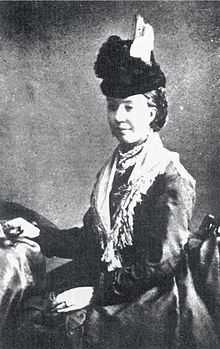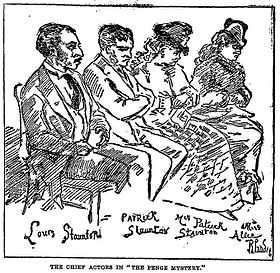Murder of Harriet Staunton
| Harriet Staunton | |
|---|---|
 Harriet Richardson at the time of her engagement to Louis Staunton | |
| Born |
Harriet Richardon 1841[1] Essex |
| Died |
13 April 1877 Penge |
Cause of death | Starvation and neglect |
| Known for | Murder victim |
The Murder of Harriet Staunton took place in the London suburb of Penge in April 1877. Harriet Staunton (nee Richardson) died in a Penge lodging house on 13 April, five days after her one-year-old child Thomas Staunton, died of malnutrition at Guy's Hospital. In September of the same year, Harriet's husband Louis Staunton was convicted of wilful murder at the Old Bailey together with his partner Alice Rhodes, his brother Patrick Staunton and Patrick's wife Elizabeth. All four were sentenced to death by hanging but the sentences were later commuted to terms of imprisonment after doubts were raised concerning the medical evidence and the impartiality of the presiding judge.
Background
Harriet Richardson's father was a clergyman from Essex who died when his daughter was twelve. She later received £5,000 from the will of a great-aunt. She was reportedly of limited mental capacity and appears to have had learning disabilities.[2]
Louis (or Lewis) Staunton (born c. 1851) was an auctioneer's clerk from Streatham. At the time of his first encounter with Harriet he was twenty-three years old and involved in a relationship with a fifteen-year-old girl named Alice Rhodes. Staunton's younger brother, Patrick, was married to Alice Rhodes' older sister Elizabeth.[3]
Louis Staunton met Harriet through Alice Rhodes' stepfather Thomas Hinksman, a relative of the Richardson family. After a brief courtship, the couple were engaged to be married. Harriet's mother Mrs Butterfield (she had remarried) was strongly opposed to the marriage and made an unsuccessful attempt to have her daughter declared a lunatic[4] and placed under the protection of the Court of Chancery. The couple were married at Clapham in June 1875. Mrs Butterfield visited her newly-married daughter at her home in Brixton, but then received a letter apparently written by her daughter saying that she was not to visit the couple in future.[2]
Crime
In March 1876 Harriet gave birth to a son who was named Thomas. At about the same time Louis bought a house called Little Grays near Cudham in Kent. In August Louis moved into Little Grays where he lived with Alice Rhodes while Harriet and Thomas were sent to live at Frith Cottage,[5] one mile away, with Patrick and Elizabeth. Mother and child were confined to a small upstairs room with no curtains, washing facilities or proper furniture. She was dissuaded from leaving the room by threats of violence from Patrick Staunton. Mrs Butterfield made efforts to contact her daughter, but when she travelled to Little Grays she was turned away by Louis. In October, Harriet attempted to escape from the cottage but was forcibly restrained and assaulted by Patrick.[6]
The infant Thomas Staunton became gravely ill in early 1877 and was taken by Patrick and Elizabeth Staunton to Guy's Hospital in London on 8 April. The child died later that day: he was severely malnourished, and had a bruise on his cheek suggesting physical abuse. On 12 April, Harriet was removed from the cottage and sent to a lodging house at 34 Forbes Road, Penge. On her arrival, she was described as looking "more like a corpse than a living woman" and she died the following day.[4] The death certificate gave her cause of death as "cerebral disease" or "apoplexy".[7]
Investigation

Suspicions about Harriet's death were originally raised by her brother-in-law Louis Casabianca, who encountered Louis Staunton in a post office where the latter was attempting to get information about recording his wife's death.[6] Casabianca went to the police and an inquest was held. Harriet's body was found to be filthy and severely malnourished: her hair was matted and infested with lice. The cause of death was now recorded as "starvation and neglect".[7] At the time of her death she weighed five stones and four pounds (74 pounds).[1]
Louis Staunton, Patrick Staunton, Elizabeth Staunton and Alice Rhodes were arrested and charged with murder. The case attracted great public attention: models of the four accused were soon on display at Madame Tussauds.[3]
Trial and review
In September, the Stauntons and Alice Rhodes were tried for the murder of Harriet Staunton at the Old Bailey with judge Henry Hawkins presiding. The case attracted great interest, with "fashionable" ladies scrutinising the accused through opera glasses and refreshing themselves with champagne.[5] The defence, led by Edward George Clarke claimed that Harriet's malnourishment was due to alcoholism which led to her refusing to eat. Medical testimony was also presented which stated that the victim had died from meningitis and tuberculosis.[8] The jury returned a verdict of guilty on all four defendants, who were sentenced to death by hanging.[2] As the verdict was read, Patrick Staunton "twitched convulsively" while Louis Staunton "stared fixedly" and appeared "completely dazed".[5] Despite the cold and foggy weather, a large crowd had gathered around the court building and cheered the verdict. In passing sentence, Hawkins said that the crime was one of the most "black and hideous" on record and commented on the incredible "barbarity" and cruelty involved.[9]
Following the verdict a letter was published in The Lancet, signed by seven hundred physicians protesting about the way that expert medical evidence had been ignored. It was also widely thought that Hawkins had exhibited bias against the accused.[8] A campaign against the verdict was led by the novelist Charles Reade and the case was reviewed by the Home Secretary R. A. Cross. Alice Rhodes was pardoned and released immediately, while the sentences of the other three were commuted to life imprisonment. Patrick Staunton died in prison, but Elizabeth was released in 1883.[3] Louis Staunton was released in 1897, still protesting his innocence,[10] and emigrated to Australia.[8]
Popular culture
The death of Harriet Staunton was the subject of a contemporary broadsheet ballad.[3]
In 1934 Elizabeth Jenkins published the novel Harriet based on the case. The novel won the Prix Femina, beating Evelyn Waugh's A Handful of Dust,[11] and was republished in 2012.
References
- ↑ 1.0 1.1 "THE TRAIL OF THE LAW". Wanganui Chronicle. 8 July 1919. Retrieved 2014-03-08.
- ↑ 2.0 2.1 2.2 Rachel Cooke (15 April 2012). "The Penge Mystery: the terrible story of Harriet Staunton". The Observer. Retrieved 2014-03-08.
- ↑ 3.0 3.1 3.2 3.3 David Leafe (13 June 2012). "Murder by starvation: It scandalised Victorian Britain". Daily Mail. Retrieved 2014-03-08.
- ↑ 4.0 4.1 "THE PENGE TRAGEDY". Evening Post. 22 October 1877. Retrieved 2014-03-08.
- ↑ 5.0 5.1 5.2 "The Penge Case". Bruce Herald. 30 November 1877. Retrieved 2014-03-08.
- ↑ 6.0 6.1 "AWFUL STARVATION MURDER". Auckland Starz. 23 August 1930. Retrieved 2014-03-08.
- ↑ 7.0 7.1 Hughes, Tom (4 September 2011). "Victorian Calendar: September 19, 1877 - The Great Penge Murder". Victoriancalendar.blogspot.com.au. Retrieved 2014-03-08.
- ↑ 8.0 8.1 8.2 "THE PENGE MYSTERY". The Star. 11 November 1897. Retrieved 2014-03-08.
- ↑ "The Penge Murder". Pall Mall Gazette. 12 December 1877. Retrieved 2014-03-08.
- ↑ "RELEASED AFTER TWENTY YEARS". New Zealand Herald. 27 November 1897. Retrieved 2014-03-08.
- ↑ "Elizabeth Jenkins obituary". Daily Telegraph. 6 September 2010. Retrieved 2014-03-08.